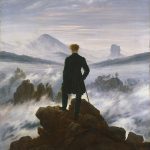
Albert Bierstadt led an interesting life, to say the least. He was born in Germany in 1830, but his family moved to America soon after, settling in New Bedford, Massachusetts. Bierstadt was raised in a well-to-do family and received a good education, but he was never one for the academic life. Instead, he quickly developed a passion for art and spent his days painting and drawing.
In 1853, at the age of 23, Bierstadt decided to move to Düsseldorf, Germany to study under the famous landscape painter Andreas Achenbach. It was here that Bierstadt honed his skills and developed his unique style of painting. He was heavily influenced by the Romantic movement, and his paintings often featured grand, sweeping landscapes, drenched in light and color.
Bierstadt’s early paintings were well received, but it wasn’t until he returned to America in 1857 that he truly made a name for himself. His paintings of the American West, with their majestic mountains and vast, open skies, captivated audiences across the country. Bierstadt’s work became synonymous with the mythos of the American West, and his paintings were often used to promote westward expansion and the idea of manifest destiny.

But Bierstadt was more than just a painter of the American West. He was a man who loved adventure and was constantly seeking new challenges. In 1863, he joined an expedition to California’s Yosemite Valley, where he painted some of his most famous works, including “Yosemite Valley, Yellowstone Park” and “The Domes of the Yosemite.” These paintings, with their incredible detail and vivid colors, brought the beauty of Yosemite to the rest of the world, and helped to establish the area as a mecca for nature lovers and artists alike.
Despite his success, Bierstadt was not without his detractors. His detractors accused him of sensationalizing the American West, of exaggerating its beauty and grandeur for the sake of his art. But Bierstadt was never one to back down from a challenge, and he continued to paint the American West with passion and enthusiasm until his death in 1902.

In many ways, Bierstadt was a man ahead of his time. He saw the beauty in the natural world long before it became fashionable to do so. He understood the power of art to inspire and uplift, and he used his gift to share the beauty of the American West with the world. His paintings were not just works of art, but testaments to the incredible beauty of the natural world, and to the boundless potential of the human spirit.
In the end, Albert Bierstadt was more than just a great artist. He was a pioneer, a visionary, and a true inspiration to us all. His paintings remind us of the beauty and majesty of the natural world, and of the limitless possibilities that lie ahead if we are willing to embrace them.




